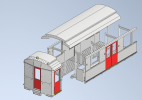mickoo
Western Thunderer
Agreed, though to be fair, none of my previous ones have worked so well (as well as I wanted) or felt so self satisfyingly smug as this oneOnce the idea forms, I have found many and various means of assisting builds

Like everyone else, I tend to view the 3D printer as a detail or model object replicator, not as a tool supplier, test pattern (Slaters SG motor pattern) or functional object (DCC chip holders) maker.





